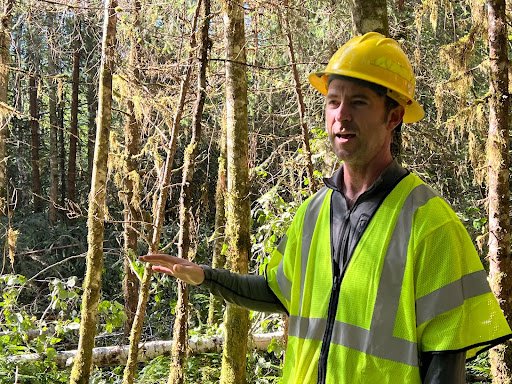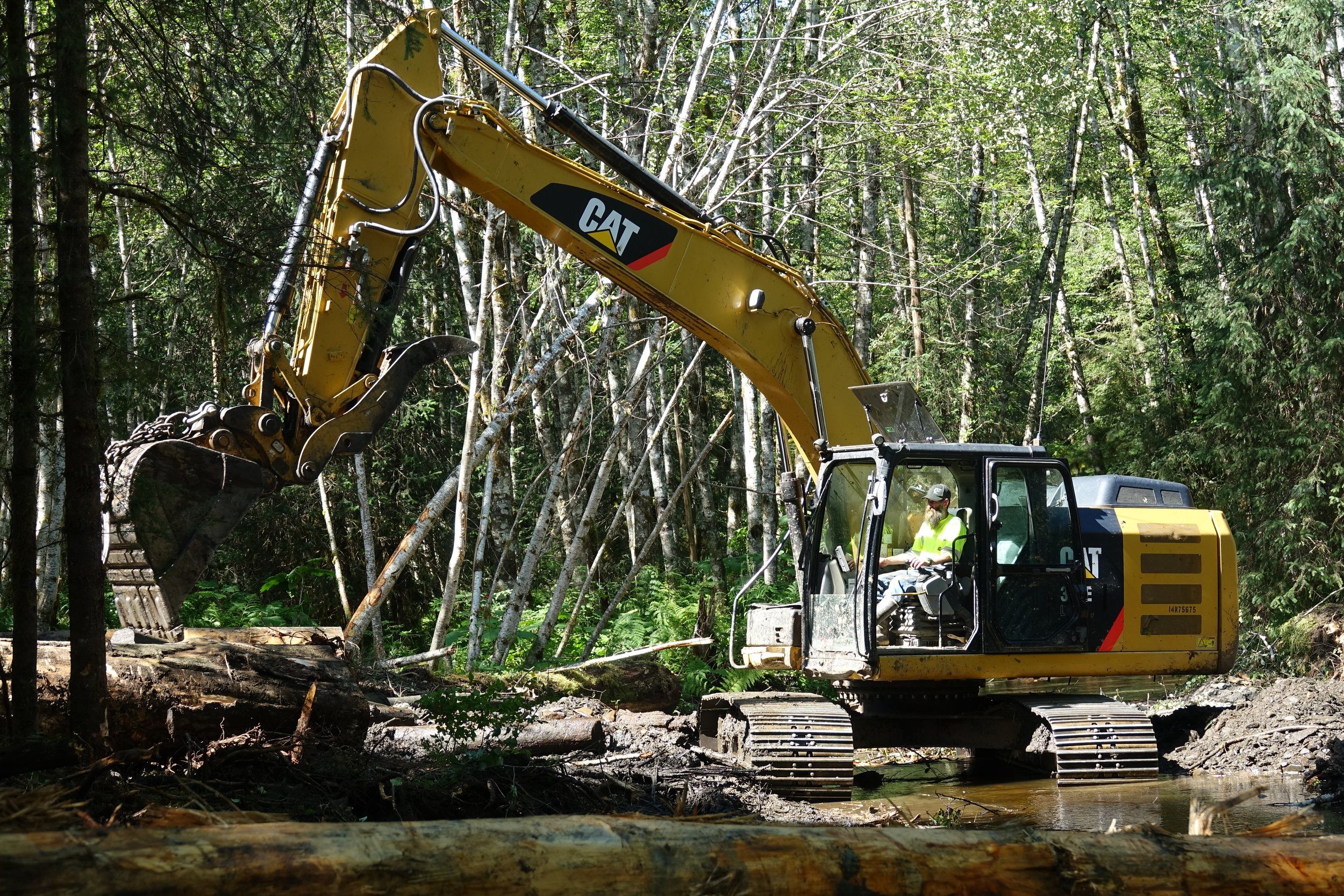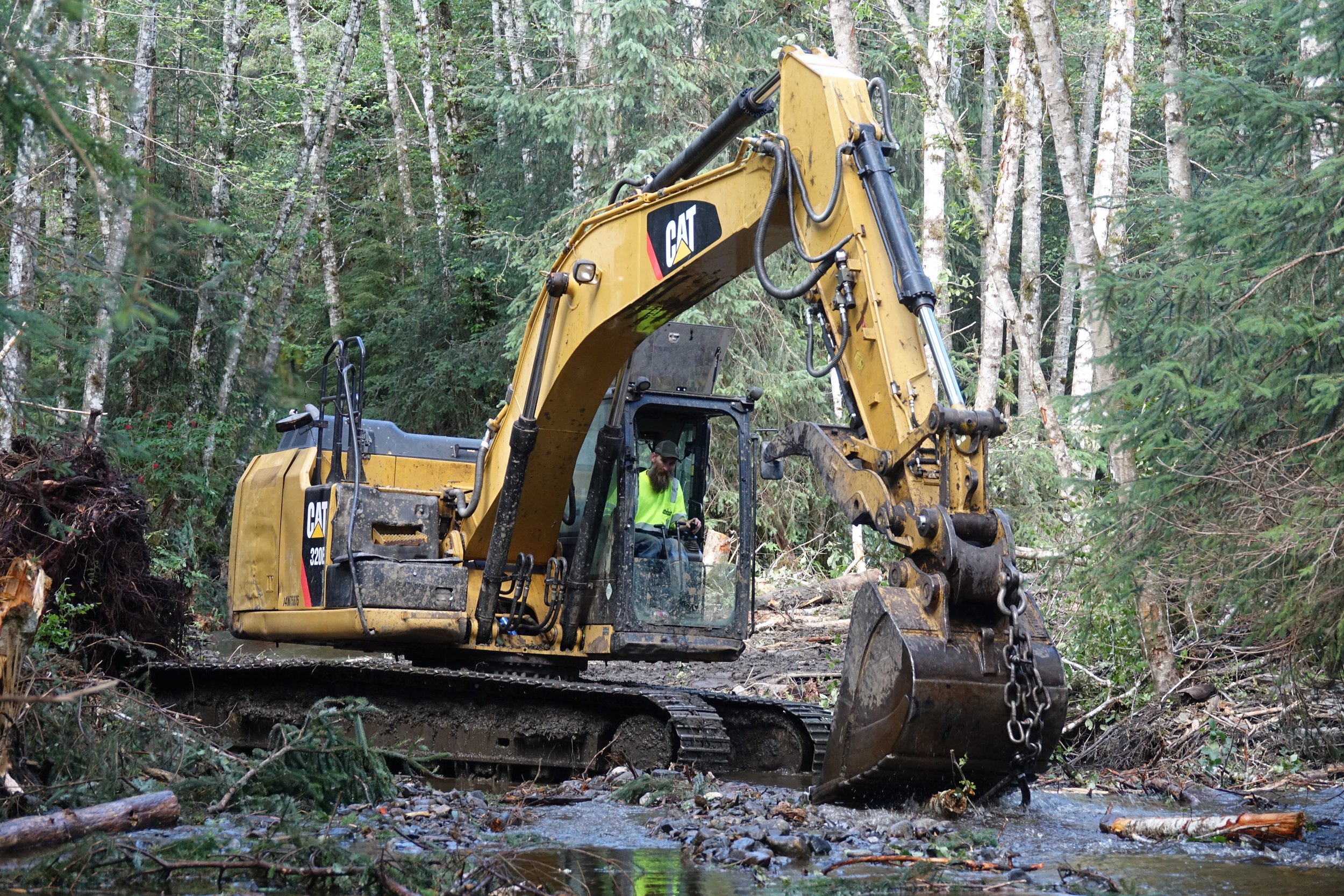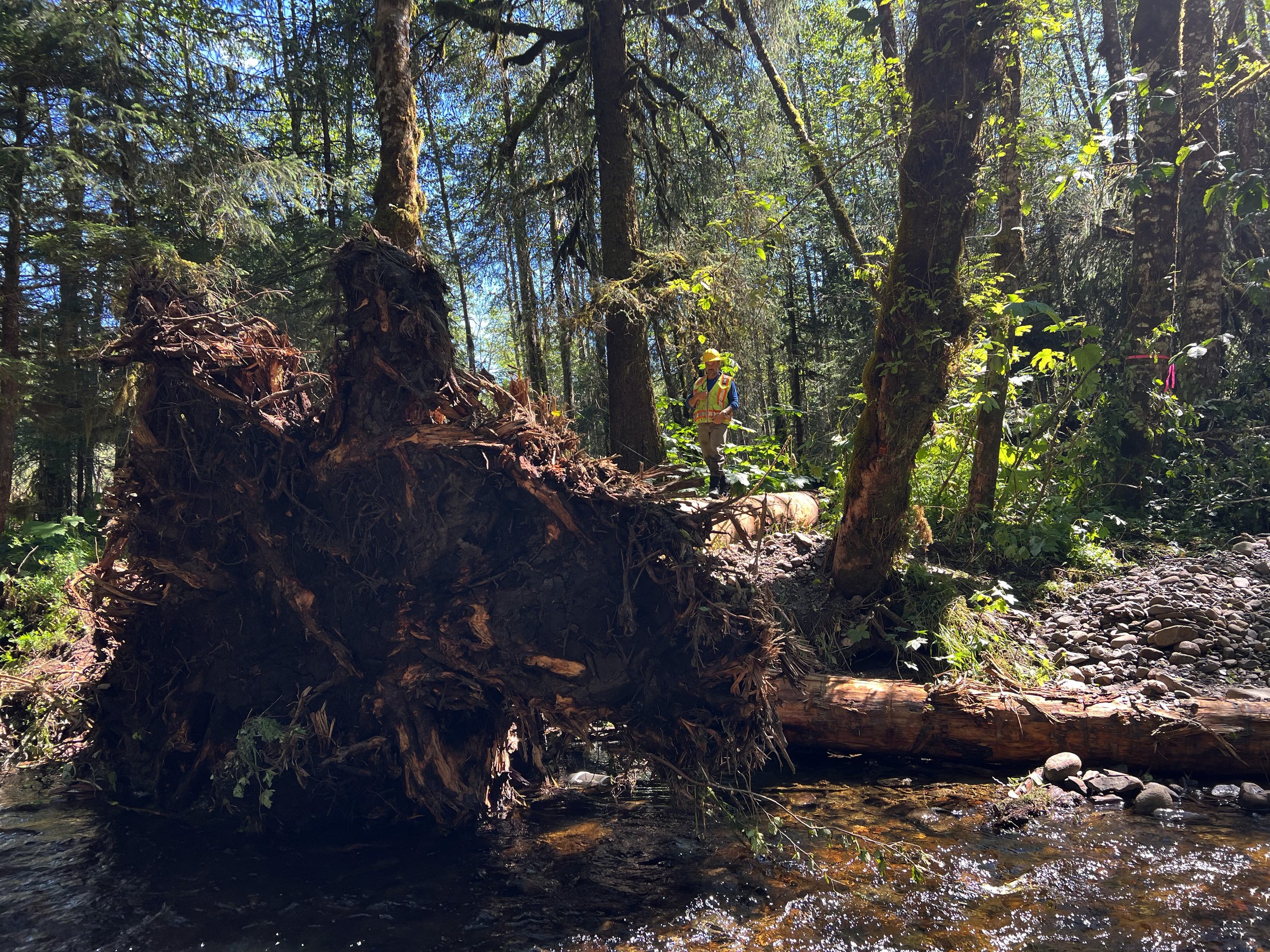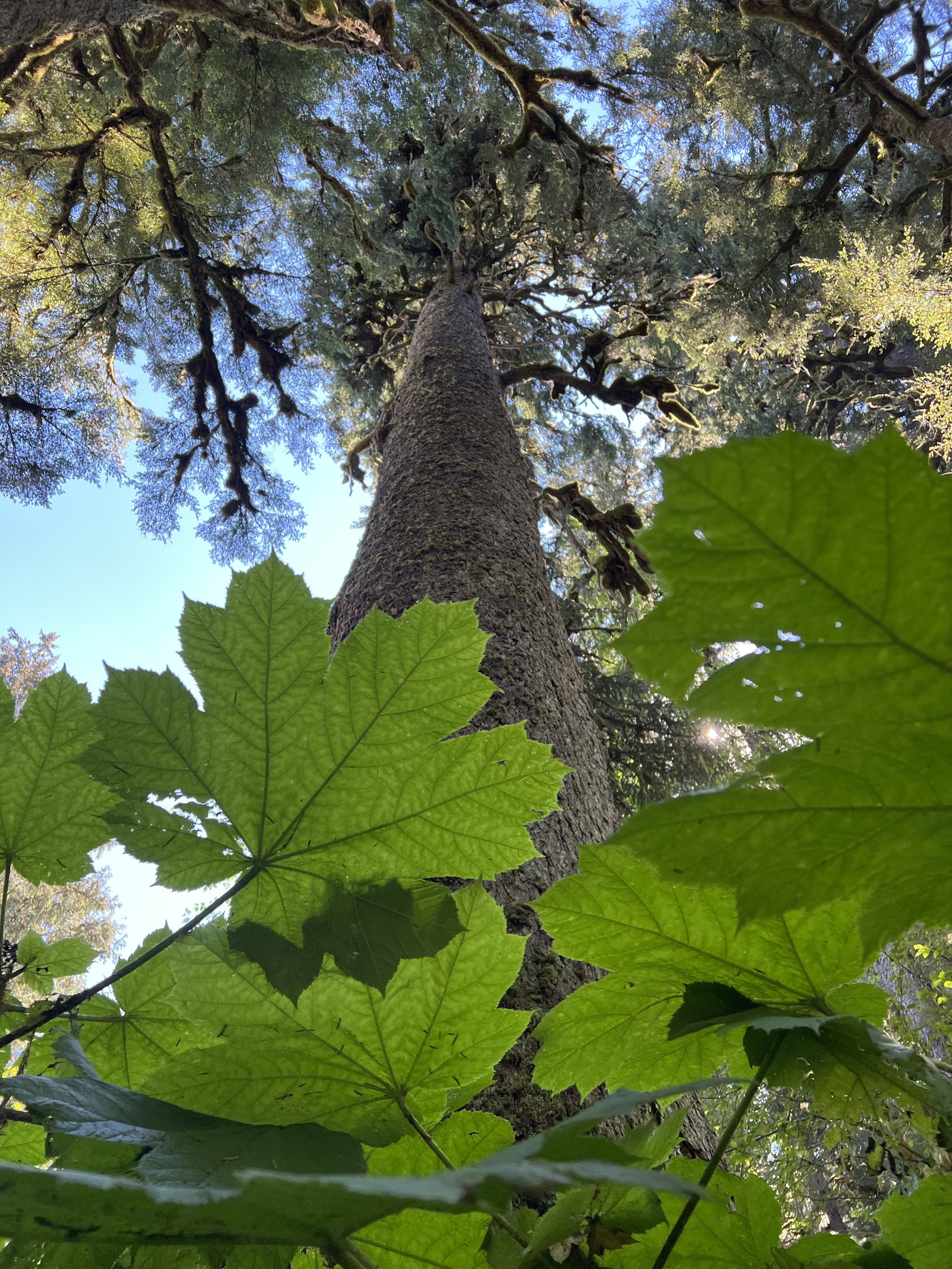Big machines helping little fish
Restoration and climate resiliency on East Ohmer Creek in Petersburg, Alaska
Petersburg Ranger District hydrologist and project lead Heath Whitacre
“I’m Heath Whitacre, and I’m a hydrologist with the Petersburg Ranger District. I’m the team leader of this project. What we’re doing in a stream restoration on East Ohmer Creek, and two of the tributaries that run into East Ohmer Creek.
There’s probably two spruce they say are the biggest on Mitkof Island. I don’t know if that’s true, but they’re giant trees, and they’re just downstream of us. So we know this area had some really large trees. Part of what happened when they harvested the trees on the floodplain, they pulled most of the stumps out and they mined the gravel to continue Mitkof Highway south. By doing that they took the top of the soil away, and the growing conditions are so poor that most trees out here are roughly four to eight inch diameter trees.
So part of what we’re trying to do is add a whole bunch of floodplain wood to improve that. Obviously soil development is sort of a centuries-long process. But we’re trying to do it faster than normal.”
—Petersburg Ranger District hydrologist and project lead Heath Whitacre
“My name’s Eric Castro, and I’m the Petersburg Ranger District Fish Biologist. This project… we’re placing wood into the creek in order to be able to stabilize bank channels, offer some complexity of habitat, and create pools. Pools are very important to fish, and we are trying to improve fish habitat and their survivability, with the changing climate and the changing times.
As a fish biologist, this right here kind of fits into my wheelhouse. I’m used to walking up and down creeks, looking at creeks assessing whether or not they could maybe use extra large wood. Sometimes you think about it and you can’t do anything. But in this instance right here, we knew that this stretch of creek needed large wood put in place to help blow out more pools, to help stabilize the banks, to help build back up the substrate so that when the river floods, it activates the floodplain.
Those types of environments are actually ten times more productive than even a floodplain system like this. So it’s one of those things that’s an order of magnitude greater. Being able to get water to fill those types of environments is vastly beneficial.”
—Eric Castro, Petersburg Ranger District fish biologist
“I noticed this area was unusual, and I just started asking old-timers around town. And some of the contractors knew who had this job back in the late 50s, early 60s, and they confirmed what I thought, that they used a portion of the floodplain to dig up gravel to extend Mitkof Highway south.
Part of all of that is just figuring out what the problem is in the first place. And with that understanding, you can figure out what you need to do to try to restore natural processes.
We put a lot of really good fish habitat in the streams themselves, but I think probably the more important thing we did in the long term is try to stabilize that floodplain, just because the growing conditions are so bad.”
—Petersburg Ranger District hydrologist and East Ohmer Creek restoration lead Heath Whitacre
“Using hand tools, and did quite a few of those. It’s incredible what you can do with hand tools, and winches, and chainsaws, and grip hoists, and all that stuff. But once you get to a certain size stream, you really need to scale up to heavy equipment. Because you just can’t move rootwads like that… they’re just too heavy. You need to scale up. So the benefit of heavy equipment is you can get big wood into these streams, and that’s sort of what they need. That wood was removed, and we’re putting it back in. It’s usually the bigger the better.
The drawback is that the footprint is a lot bigger. You need to access stream channels with machines that weigh 110,000 pounds, and there’s no roads to them. So you have to sort of log your way in and punch a trail down, which is basically a corduroy road built with wood, and then walk machines in, and they need enough room to swing booms and work. So the footprint with heavy equipment tends to be shocking to some people. And it basically looks like a construction site, and it will for four or five more years, until we start to get more vegetation. But the amount of work you can get done in a short period of time is astounding. And basically when you’re working in a stream this size, you need a larger framework in place, and it’s really the best way to do that.”
—Petersburg Ranger District hydrologist and East Ohmer Creek restoration lead Heath Whitacre
“This has been a long project. We’ve been planning it for more than five years. So my favorite part was the first day, when we were actually working in the stream building our first structure. It was like great, this is finally happening. Here we are, and we’re going to make it better.
And I do enjoy seeing these operators work. We’re lucky enough to have a skilled operator in Jode Coil. He works for Rock-N-Road Construction, and he’s fun to watch, because he’s so skilled at getting 60 foot trees with rootwads attached into these tiny little holes that shoot off sixty feet from the stream and lay it on the floodplain, and get them where you want them — his spatial awareness is pretty incredible.”
—Petersburg Ranger District hydrologist and East Ohmer Creek restoration lead Heath Whitacre
“This is the first time I’ve ever done one of these projects, and I didn’t really understand it beforehand. After being down in there and seeing exactly what they’re doing, I figured it all out. It’s like ‘Okay, I see what’s going on here.’
I figured out what their goal was on the stream restoration projects. To make pools, make deeper waters for fish to hold up in so they’re not always in the riffles, and just better spawning and habitat for the fish themselves.”
—Tom Lutton, heavy equipment operator, Rock-N-Road Construction, Inc. in Petersburg
Rock-N-Road heavy equipment operator Jode Coil at work in East Ohmer Creek
“I like just being out in the woods. I’ve done utility work my whole life, worked in town, right in the public’s eye, people around, lookie loos, always having to watch what you’re doing so you don’t hurt anybody else, don’t knock down any buildings, don’t destroy a car that’s trying to sneak through your job site — so this was just like wide open. I enjoyed that. Nobody in the way, and you just get to concentrate on what you’re doing. My concentration isn’t drawn away because of ten people walking by, or three cars trying to sneak through your job site. You just go straight on to work.
You definitely have to be aware of your surroundings. You can destroy one of these pieces of equipment really quick, if you’re not careful. If you knock a tree down on yourself, it can cause thousands and thousands and thousands of dollars worth of damage really quick. So you have to still be aware of your surroundings. But your surroundings don’t move.
I think that the younger generation – I think if they could witness stuff like this, and see what’s going on, and maybe be on the job for a day – I think it would pique their interest. It’s not boring. It’s actually pretty exciting work.
I would love to (do work on these kinds of projects again.) It’s a lot of fun.”
—Tom Lutton, heavy equipment operator, Rock-N-Road Construction, Inc. in Petersburg
Petersburg, backdropped by the Devil’s Thumb. Photo by Bjorn Dihle
“I sportfish. Not a lot, but enough. Enough to appreciate this kind of stuff. And I was raised around here, and my brother is a commercial fisherman, and a lot of my friends are. It all adds up.
In my own free time I love to be out in the woods, I love to be on the water. So getting out of town and not working in people’s yards, not working on streets, this was a real treat for me. To be out in the woods all day. It’s what I like to do. I’m also getting paid for it, so it’s a double bonus.
I feel personally that the fish runs in this creek have slowed down since I was younger, and I think stuff like this only improves it."
—Tom Lutton, heavy equipment operator, Rock-N-Road Construction, Inc. in Petersburg
Eric Castro walks along a recently placed tree and rootwad in East Ohmer Creek.
“I feel that an underappreciated aspect of heavy equipment restoration — restoration in general, but specifically heavy equipment restoration — is the necessity for wood. We need to be able to source this wood. So I feel that it would be beneficial for the public to know that this wood had to be harvested off the landscape. It was done so in a sustainable manner, and now we’re actually using it in a creek where it had been robbed from in the past.
We have skilled fallers who otherwise are just putting in roadways, and we’re able to utilize their talents on something beneficial to the ecosystem, where they themselves are excited to bring their families down to go swim in these pools, to show them the habitat that they’ve helped create.
You don’t have to just sell it to China, or mill it into boards. The fact that these trees can actually be used effectively in the landscape is powerful.”
—Eric Castro, Petersburg Ranger District fish biologist
“My name’s Taran Snyder. I got involved in this project through Eric Castro and Heath Whitacre at the aquatics department of the Forest Service at the Petersburg Ranger District. They brought me on as an intern through VetsWork Environmental, which is a development program aimed to either garner (veterans) the experience necessary to go on to graduate school or to gain you full time employment within the federal government. And they brought me on, and I have been learning hands on, kind of being their apprentice and shadowing them throughout the season so far, since February.
After my first couple of months up here… I realized I am thoroughly enjoying aquatics, specifically. And this project, working with Heath (Whitacre) and learning everything that man has in his noggin — he is just a wealth of knowledge. And it is invaluable learning everything that I’ve been able to learn here.
Maybe I will be a hydrologist one day, just like Heath. Learning this project and how water works, and how you can manipulate it with just wood is fascinating.”
—Taran Snyder, intern through VetsWork Environmental
Taran, Eric Castro and Heath Whitacre watch heavy equipment operator Jode Coil at work.
“I was 17 when I enlisted in the Army. I had my parents sign off. I went to basic training. I spent 8 years total in the Army, and jumped around quite a couple of times. I lived all throughout the States. When I got into my last year in the Army, I was more administration, and that didn’t really sit well with me. So … I left the Army under honorable conditions after my contract expired, and immediately was accepted into Colorado State University in Fort Collins.
I graduated CSU after three years, got my degree, boogied out of there, thought I was big and strong and going to go take on the world with that degree. Then I ran into the loophole of — it’s hard to get into science, it turns out, especially with only a bachelor degree.”
“So I started playing around with the idea of graduate school while working at American Furniture Warehouse in Colorado. I did a lot of heavy lifting.
One day, I think it might have been maybe November or December, I randomly saw on Indeed a job posting for VetsWork Environmental, through the Mt. Adams Institute. I read what they were offering and it sounded pretty dang cool and kind of too good to be true. So I applied.
Lo and behold, I was the one that was chosen to come out to Alaska, to Petersburg, for 10 ½ months. So the program started February 7, and it is slotted to end December 16. Since February 13 I’ve been feet on the ground, going full bore. It’s kind of funny, doing this interview now (in late July), I actually have already accomplished my goal as of right now — finding a full time job in my field.”
—Taran Snyder, intern through VetsWork Environmental
VetsWork is looking to place Alaskan veterans interested in natural resources and our wild landcape in Alaska field positions, including salmon restoration! Learn more about them at https://mtadamsinstitute.org/vetswork-environment/
“Habitat restoration is an essential element of being able to support sustainable populations. In order for us to have the maximum amount of fish potential, be it for sport fishermen, or commercial fishermen, subsistence, we need to be able to have healthy landscapes. These type of restorations only occur in areas that have been disturbed by previous actions. So what we’re doing is rectifying what we did wrong in the past. This is something that can continue throughout Southeast.”
—U.S. Forest Service Petersburg Ranger District fish biologist Eric Castro
“This project here is immediately beneficial to locals. We have a local contracting company we’re working with, and all the federal funding and other stimulus money that we’ve been able to put into this goes back into the community and it stays here. And I feel that that’s what we’d like to be able to see more of.”
—U.S. Forest Service Petersburg Ranger District fish biologist Eric Castro
Heath Whitacre and Taran Snyder confer as equipment operator Jode Coil maneuvers trees into place to diversify and better habitat.
“This fall I can come down and see how things have diverted, and after the winter I can come down and see what kind of changes it actually made to the stream. So that’s going to be kind of nice. Then I’ll even have a better understanding.
When we first got down there, in quite a few places, where you would think were the deeper ponds – which they were at the time, but they were still very shallow and real swift moving water all the way through them. After we left, after they did their grade control logs and stuff, as we pulled out, the next day I got down in there and I could see those certain pools, even though we didn’t get any rain, they actually had deeper water in them than they did the day before. Which, that’s kind of the goal, and it seemed to have worked.
It is for the better in the long run, I feel, especially after actually witnessing it and observing it day to day. A lot of people might think ‘Oh, they’re just down there wasting money or whatever.’ No. It’s for the long haul. It really is. And I can see that, after working here for a day or two.”
—Tom Lutton, heavy equipment operator, Rock-N-Road Construction, Inc. in Petersburg
VetsWork intern Taran Snyder, fish biologist Eric Castro and hydrologist Heath Whitacre, all with the U.S. Forest Service Petersburg Ranger District, walk upstream at East Ohmer Creek.
“There are still many of these heavy equipment projects to do. They tend to be focused in some of the areas that were hit a little bit harder with the timber harvest. Like Prince of Wales. Sitka I think still has lots of work to do. Next year, we’re going to do another fairly large one on Kuiu Island. But that’s only speaking to the Forest Service portion of that. But the thing that I’m excited about, and where I think a lot of restoration is going, is that we’ve been able to have workshops with many of our partners, and Native communities and work crews are doing this work — improving things for fish, and improving the floodplain and riparian area. So I think that’s exciting. It’s different around the forest.
“Now is kind of a special time with sort of a shift in priorities on the forest. And restoration and recreation have become more important, and are receiving more funding. So it’s not as difficult as it used to be to fund these projects.”
—Petersburg Ranger District hydrologist and East Ohmer Creek restoration lead Heath Whitacre
“It’s easy to think about restoration as being something that is super clean, and is perfect right away. But it’s a process. You can’t make an omelet without breaking a few eggs. So there’s a period of time when it’s a bit messy, but there is a game plan. And this is all part of it. And what’s great about that is that there are a number of different elements that are necessary. We need skilled operators. We need timber fallers. We want a community that supports this type of activity. We have gone through the environmental assessment to determine that this will have long-lasting benefit to this environment, and we would love to show people that this is something that is impactful not only for the fish, not only for the stream channel, but for the communities that are around these systems.
Bang for the buck, stream restoration is where it’s at. Because it utilizes local citizens in order to be able to do the work, it creates an environment that is conducive to happy fish, and it creates potential swimming holes for happy kids. So that’s something that we would like to see more of.”
—U.S. Forest Service Petersburg Ranger District fish biologist Eric Castro



